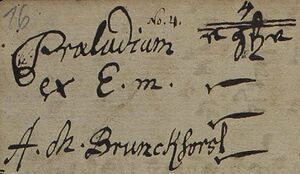Arnold Matthias Brunckhorst

Arnold Matthias Brunckhorst (1670?-1725) was an organist and composer.
In 2006, the Prelude in G Minor previously thought to be composed by Nicolaus Bruhns was connected to Brunckhorst by Dietrich Kollmansperger.
Life
Brunckhorst worked in Hildesheim from 1693-1697. After this he went to the Stadtkirche in Celle. During this time he worked for Duke Georg Wilhelm of Brunswick-Lüneburg. In 1720, he became the Hanover court organist. He passed away in 1725.
Brunckhorst also worked as an organ tester.
Around 1700 he may have met the young J.S. Bach on one of his visits from Lüneburg to hear the duke’s famous French instrumentalists.[1]
Prelude in G Minor

When D-B Mus.ms. 30381 was discovered, the Prelude in G Minor by "Mons. Prunth" was attributed to Nicolaus Bruhns by Martin Geck. While this attribution remained, it was not considered entirely satisfactory, and other possibilities were considered. This piece was also previously speculated to be composed by his brother Georg Bruhns, although no works survive from him.[2]
In March 2006, Dietrich Kollmansperger published an article in Ars Organi in which he proposed that the piece was in fact composed by Brunckhorst. Unlike the three other preludes by Bruhns, this piece is only in two parts, a prelude and a fugue. Additionally, the Prelude in G Minor contained a rhythmic continuality[3] that was not present in the other works but can be found in the Prelude in E Minor by Brunckhorst.
Kollmansperger showed stylistic similarities between the Preludes in E Minor and G Minor, such as the beginning of both pieces and the ending of the Prelude (first half) in which both pieces go into an adagio section before the fugue.


Klaus Beckmann responded to this article in Ars Organi in June 2006. He agreed with the findings by Kollmansperger, and furthermore pointed out that the use of the neopolitan 6th in both adagio sections is an unmistakable fingerprint of the same composer.
For even more evidence of the connection beyond stylistic grounds, Beckmann pointed out that Prunth: was a realistic mispelling of "Brunckhorst" (Brunckh -> Prunckh -> Prunkh -> Prunth), and that the surviving harpsichord sonata by Brunckhorst is signed di Mons. Brunckhorst. It is possible that the sonata was signed Mons[ieur] Brunckhorst.
In closing, Klaus Beckmann wrote that the case of Brunckhorst over Bruhns was a convincing, almost certainly correct solution based on rare clarity, for which Kollmansperger was deserving of thanks and recognition. Afterwords, he re-issued the 7th volume of Meister der Norddeutschen Orgelschule containing the complete works of Bruhns (which had been previously published in 2004) as a two-composer volume including Arnold Matthias Brunckhorst, including both of his compositions.
Works
| Source | Title | Incipit | Notes | ref. |
|---|---|---|---|---|
| Organ works | ||||
| D-LEm Becker II.2.51 part 5, p.16-19 | Praeludium / ex E. m. / A. m. Brunckhorst | Prelude Fugue  |
[4][5] | |
| D-B Mus.ms. 30381 No 4 | Praludium con Fuga. ex G b. / pedaliter. / di / Mons: Prunth. | Prelude Fugue  |
[6][7] | |
| Keyboard works | ||||
| D-B Mus.ms. 30382 f.86r-87v | Sonata ex A #. / di / Mons: Brunckhorst. | [8][9] | ||
References
Beckmann, Klaus, Die Norddeutsche Schule. Teil II: Blütezeit und Verfall. Mainz: Schott, 2009. 547.
Beckmann, Klaus. "Diskussion: Zur Neuzuweisund des Praeludiums g-Moll di Mons: Prunth. an Arnold Matthias Brunckhorst." Ars Organi 54. Jfg. Heft 2, June 2006. p.111-112.
Kollmansperger, Dietrich. "'Mons: Prunth', Präludium g-Moll: Eine Neuzuweisung." Ars Organi 54. Jfg. Heft 1, March 2006. p.30-31.
Schröder, Dorothea, Brunckhorst, Arnold [Andreas] Matthias [Melchior, Martin], 20 January, 2001. Grove Music Online, accessed 11 August, 2023.
- ↑ Schröder
- ↑ Beckmann, Klaus (editor), Nicolaus Bruhns: Sämtliche Orgelwerke. Meister der Norddeutschen Orgelschule 13 [earlier edition, not including Brunckhorst]. Mainz: Schott, 2004.
- ↑ Kollmansperger: "eine rhythmische Kontinuität"
- ↑ sachsen.digital, accessed 11 August, 2023. Mirrored: IMSLP870142
- ↑ RISM225006522
- ↑ digital.staatsbibliothek-berlin.de, accessed 11 August, 2023. Mirrored: IMSLP870141
- ↑ RISM455038261
- ↑ RISM455038336
- ↑ digital.staatsbibliothek-berlin.de, accessed 16 August, 2023.